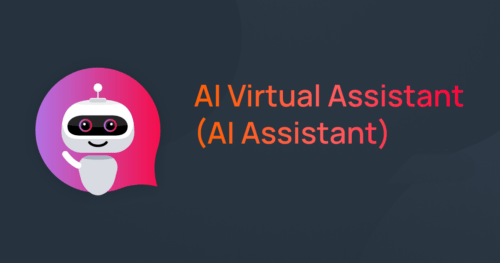What Are AI Virtual Assistants?
An AI Virtual Assistant is software powered by artificial intelligence (AI) that responds to inquiries in a human-like language in text or voice format. It leverages natural language processing (NLP) to process, understand, and generate responses to system users in a conversational manner.
The AI assistant is merging analytics and cognitive computing, drawing on unique user or customer data, prior dialogues, and location information, all while harnessing the organization’s knowledge repository and human understanding.
How Does an AI Virtual Assistant Work?
An AI Virtual Assistant leverages advanced AI technologies, including natural language processing (NLP) and Large Language Models (LLMs). NLP is the foundation of any AI assistant, enabling it to understand and respond to queries and answer them in a human-like interaction.
Let’s begin by elucidating and gaining a deeper comprehension of the prevalent AI terms associated with AI virtual assistants.
AI Virtual Assistants are Powered by Conversational AI
AI Virtual Assistants are a prime example of conversational AI, which manifests Artificial Intelligence (AI) through the simulation of conversations with human users. They obey automated rules and use capabilities called natural language processing (NLP) and machine learning. Working together, these advances allow chatbots to process data and respond to all sorts of commands and requests.
A conversational AI platform is propelling the world with astounding levels of automation that drive productivity up for service teams and costs down. New advancements in AI technology are upgrading today’s traditional chatbot to an advanced AI assistant and moving it toward agentic AI.

From Conversational AI to AI Agents
That’s where conversational AI comes in. But not all chatbots use that technology. In old assistants, there were two types of chatbots: the simple task-oriented kind and the more advanced, data-driven and predictive kind, also known as virtual assistant chatbots.
Conversational AI assistants or enterprise chatbots are context-aware bots that use NLU, NLP, and machine learning to get smarter as they go. They can personalize conversational flows and responses based on user profiles and other information they have. They can even remember your preferences and offer solutions and recommendations, or predict what you might need next. Some advanced AI copilots can proactively initiate conversations, guide users through complex processes, or offer timely support.
AI assistants can pull information from each conversation and aggregate that to answer a question or complete a task. With AI assistance, they keep the context right where it should be. Domain-specific AI agents take this a step further by leveraging specialized knowledge to enhance accuracy and provide tailored responses in specific environments, like IT or customer support.
That’s where the real power of virtual assistant technology comes in. By connecting those single-purpose chatbots under one umbrella and integrating AI copilots and AI agents, AI assistants can make all of them more effective. And that video we’re promoting will show you just how far chatbots, AI copilots, and task-oriented virtual assistants have come in conversational AI.
AI Personal Assistants: Different Types of AI Virtual Assistants
AI personal assistants are software programs that use artificial intelligence to do daily personal tasks. They can be text assistants, voice bots or a combination of both. For example, Siri and Alexa fall under this category.
They can work like an executive assistant but are powered by NLP and Machine Learning algorithms algorithms to understand and respond to user commands and improve over time for a personalized experience. With voice data growing, they are becoming essential AI tools in our daily routines and digital transformation.
AI Voice Assistant
When it comes to voice assistants, there are various tools available, ranging from free plans to premium versions, such as Aisera’s AI Voice Bot for enterprises. You may wonder what AI voice assistants are and how they differ from AI text-based assistants. AI voice assistants and text-based AI assistants are two forms of AI technology designed to streamline human-computer interaction.
Virtual assistant voice services like Google Assistant, Alexa, or Apple’s Siri utilize an AI voice bot with speech recognition technology to interpret and respond to verbal prompts and voice interaction. They transform spoken commands or voice queries into actions, offering hands-free convenience ideal for multitasking or accessibility purposes.
Conversely, AI text assistants such as Conversational assistants or virtual agents leverage natural language processing to understand and reply to written prompts. They are widely implemented in chatbots and AI customer care bots, assisting in tasks such as email drafting and instant messaging.
AI voice assistants are now using multilingual conversational AI, which is why we see them in different countries. For example, the government of India has developed a project named GoVocal AI, an Indian AI voice assistant that works like Alexa or Google Assistant but in the Hindi language.
The main difference is in the mode of communication: voice assistants are auditory and speech-based, text assistants are visual and text-based. This difference is due to various user needs, contexts, and preferences, and ultimately, the diverse AI application landscape. But both are moving towards more conversational and natural human-computer interaction.
We all have experienced at least one of the personal assistant AI examples below:
1. Apple Siri:
Siri is one of the most popular virtual assistants. Siri is an AI-powered digital assistant on iPhones, iPads, and Macs. You can do many things with voice commands, like set reminders, send messages, make calls,and search the web. Siri also integrates with other apps and services on Apple devices for a seamless and personalized experience.
2. Amazon Alexa:
Amazon Alexa is a popular virtual assistant in Amazon Echo speakers. You can do many things like play music, get weather updates, control smart home devices, order products from Amazon, and answer general knowledge questions. Alexa’s skills can be expanded through third-party integrations so it’s a very versatile and customizable virtual assistant.
3. Google Assistant:
Google Assistant is available on Android devices and Google Home speakers. It has many key features like voice-controlled search, personalized recommendations, smart home control, meeting scheduler, and access to various Google services. Google Assistant is known for its natural language processing for text and speech recognition, and can understand the context for more conversational interactions.

Benefits of AI Virtual Assistants and Key Features
Boosting Workplace Productivity
Advanced AI virtual assistants are sometimes called AI assistants. They take over the routine tasks that eat away at employees’ time, freeing them up to focus on the work that really matters. That means more time for creativity, strategy, and innovation. And a more motivated workforce. That’s where you see real productivity growth. The AI employee experience is all about making that happen and improving employee satisfaction and engagement in the process.
Cost Savings through Automation
Cost savings through automation are a no-brainer. By taking over customer service tasks, virtual assistants reduce the need for so much human labor. That means businesses can streamline operations and save money without sacrificing service quality.
24/7 Customer Service
Around the clock customer service is a given with AI assistants. That means customer inquiries get answered whenever, wherever. And that consistency builds trust. Strong customer relationships are built on reliability and trust. Today, AI assistants are everywhere-from professional software to social media platforms. That means seamless omnichannel customer service.
Enhancing Customer Experience
AI customer experience is a capability of AI virtual assistants that not only meets customer needs efficiently but also enhances overall satisfaction. By delivering prompt and accurate support, businesses can significantly improve their customer service, leading to improved customer retention and loyalty. This 24/7 support system ensures that businesses are always there for their customers, creating a positive and enduring customer experience.
Hassle-Free Integrations
AI assistants work with your existing workplace tools like project management software, email platforms, and collaboration apps. For example, they can assign tasks in project management tools, generate AI-powered email responses, or analyze data in spreadsheets. This integration means employees can access AI right within their existing digital environment, reducing context switching and increasing productivity.
Knowledge Discovery and Information Retrieval
AI assistants help with knowledge discovery by aggregating information from multiple sources like employee handbooks, knowledge repositories or system data. Employees can ask natural language questions and get the answer quickly, reducing time spent searching for resources. This is especially useful in large organisations where information is spread across systems, so employees can make decisions and get tasks done faster.
Simplify Approvals and Workflows
AI assistants can automate multi-step processes like expense approvals, timesheet submissions, or IT ticket resolutions. By consolidating notifications and allowing employees to review and approve requests in one place, these tools reduce email clutter and simplify complex workflows. This saves time and increases departmental efficiency in HR, finance and IT.
Collaboration in Hybrid Workplaces
In hybrid work environments, AI assistants facilitate collaboration by providing real-time project updates, task assignment,s and communication. They can generate comprehensive status reports based on workflow data, so remote and in-office teams are aligned. This is key to productivity and transparency in distributed teams.
Privacy and Security
Privacy is a big barrier to AI adoption. AI assistants need access to sensitive data, and if not managed properly, can be a risk. Training data biases can lead to unfair outcomes. Organizations need to have robust security within agentic AI system with transparent data policies and bias mitigation strategies for ethical and responsible AI use. Clear regulations and user education are key to building trust.
Measuring Productivity Gains
Measuring the impact of AI assistants is key to justifying the ROI with AI. Organizations can track metrics like time saved on repetitive tasks, reduced response times, or improved task completion rates. For example, studies show AI users save over 30 minutes a day, and programmers using AI code twice as many projects a week. Implementing rating systems for AI interactions will help validate the value.
The Role of AI Virtual Assistants in Different Industries
AI virtual assistants are transforming various sectors in different roles, from IT specialists to project management, including:
- Healthcare: LLMs in healthcare are being utilized extensively nowadays. Conversations AI are used to schedule appointments, remind patients to take medication, and even offer basic health advice. They can also analyze patient data to provide personalized care.
- Banking: Utilizing generative AI in the banking sector, as an AI virtual assistant, is also very common now. with account inquiries, transaction alerts, and fraud detection. They also provide financial advice based on users’ spending habits.
- Education: Digital assistants help personalize the learning experience, provide learning resources, and answer student queries. They also assist teachers in grading and administrative tasks.

Best AI Assistant for Enterprise
In the era of AI assistants, AI agents are transforming our interactions with technology in profound ways. When it comes to the enterprise Copilot, Aisera Shines. Aisera delivers an AI Service Management (AISM) solution that leverages advanced Conversational AI and automation to provide an end-to-end Conversational AI Platform. These advanced AI capabilities automate tasks, actions, and workflows for ITSM, HR, Facilities, Sales, Customer Service, and IT Operations.
Ethical Considerations in the Use of AI Virtual Assistants
AI assistants, while offering numerous advantages, also come with some challenges. Despite advancements in AI, virtual assistants can still struggle with complex tasks and may require human intervention. Additionally, there can be a lack of personal touch that only humans can provide.
One of the main concerns is privacy. AI virtual assistants often require access to sensitive data to function effectively, which may pose a risk if not properly managed. It’s essential that adequate security measures are in place to protect this data and that users are made aware of how their data is used.
Moreover, as AI virtual assistants often learn and adapt from interactions, they may unintentionally reinforce biases present in the data they are trained on. This highlights the need for robust and unbiased training data.
As AI virtual assistants become more advanced, they will be making more decisions on behalf of humans. This brings up questions about responsibility and accountability. For instance, who is to blame if an AI assistant bot makes a mistake or causes harm?
To ensure the responsible use of AI assistants, a combination of clear regulations, transparency from AI developers, and informed users is necessary. Developers should strive to create AI that respects users’ privacy, values, and rights. Users, on the other hand, need to be informed about the capabilities and limitations of AI assistants and how to use them responsibly. The reliability of the company providing the virtual assistant is a key factor to consider.
The Future of AI Virtual Assistants (Digital Assistants)
As we continue to innovate and push the boundaries of AI, the future of digital assistants is looking bright. Expect advancements like emotion and automatic speech recognition, more nuanced conversations, and improved personalization.
Increased Autonomy
As AI evolves, expect your virtual assistant to become even more independent, learning from past interactions to predict and perform tasks without needing to be asked.
Enhanced Personalization
AI-Powered Virtual Assistants of the future will likely be even better at learning our preferences, habits, and routines, enabling them to offer more tailored assistance.
Conclusion
AI virtual Assistants, empowered by advanced AI technologies like NLP and ML, are transforming interactions by providing personalized, human-like responses. These assistants enhance productivity by automating tasks and offering round-the-clock customer service. As technology evolves, it promises to further revolutionize our digital experiences, making them more intuitive and efficient.
Now enterprises can deliver greater real-time self-service resolutions through consumer-like service experiences for employees and customers. Digital acceleration and transformation for conversational interfaces are achieved in seconds with Aisera. Book a custom AI demo for your enterprise today!

